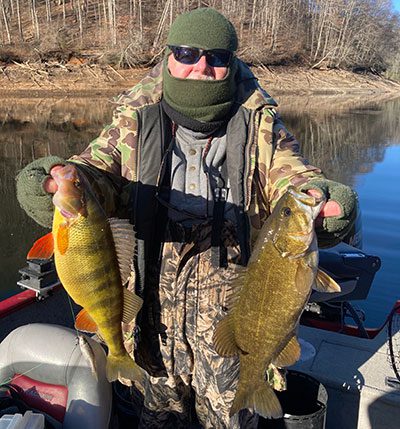As everyone who fishes any amount of time on our lakes in the Western North Carolina area knows, an invasive species of bait fish has become well established; this would be the Blueback Herring. These prolific breeders seem to have taken over at alarming rate. The average size of the Herring seems to be 5 to 7 inches. The only good thing to come from the Herring population surge is the size of the fish that feed on them. Every fish species in our lake seems to love eating the Herring, the only fish I haven’t seen them in is Buegill. I’ve even seen Bluebacks in fish not noted for eating big baits, such as yellow Perch and Crappie. So what’s the down side you might ask? Well, every lake that has been introduced to Herring has seen a disappearance of their Walleye. Some biologists say the Herring have an enzyme that when eaten enough by the Walleye will render the Walleye sterile. Not all biologists agree with this but what everyone will agree on is that, when you start seeing them in your lake, the Walleye catches will slowly dwindle.
Another fish that has almost been eliminated are the Kokonee Salmon that were established in Nantahala Lake. Most agree that the Bluebacks are feeding on the salmon and the other fish species’ eggs and eating the hatched fingerlings. The only cure to control the blueback numbers seems to be introducing fish species that will follow the big schools of Bluebacks, feeding on them and therefore lowering their numbers. Lakes, like Hiwasee, have been stocked with the best fish, in my opinion, for reducing Blueback numbers by adding stripers.
The striped bass are a great sport fish, as well as great table fair and, in a day, will eat pounds of the Bluebacks. Chatuge has had good luck with the hybrid bass, which is a cross between a striper and a white bass. Glenville has had good results with the Triploid Brown Trout that grow really fast and are voracious feeders. The last two years, Fontana, Nantahala, and Santeetlah have had double the threadfin shad than in previous years. I think this is due to the fish feeding on the Bluebacks instead of threadfin and also the Walleye and other fish species numbers being lowered by the Bluebacks.
What should be done to remedy the overpopulation of Bluebacks? I’m not a biologist so I can’t say for sure. What I have seen is that the lakes with hybrids and stripers seem to be doing the best to recover from these voracious invaders. What I do know is that we can’t sit back and just hope the situation resolves itself. Hopefully, our North Carolina wildlife biologists will be proactive and get a handle on these invaders. Thus far, I’ve failed to see the reaction that’s needed to bring our mountain lakes back to their original glory. As always, please be safe on the water and take a kid fishing!
Ronnie Parris is owner and head guide of Smoky Mountain Outdoors Unlimited-Fontana Lake Fishing Guides, headquartered in Bryson City, N.C., heart of the Great Smoky Mountains www.smounlimited.com; (828) 488-9711).
